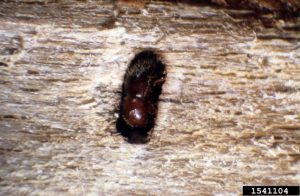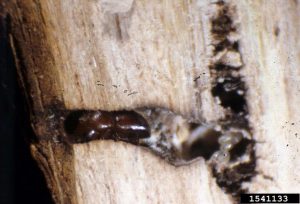
Ambrosia beetles are common pests of many woody ornamentals and native trees. Specifically, those belonging to the genus Xylosandrus, are known to infest over 200 species of cultivated woody ornamentals and shrubs. Some of these host species include sweet gum (Liquidambar styraciflua), maple trees (Acer spp.), oak trees (Quercus spp.) and magnolia trees (Magnolia spp). These Coleopteran pests damage host plants as they bore into stem and tree trunks, excavating galleries within vascular tissue as they feed.
Currently dispersed worldwide, they are primarily found in tropical to warmer temperate areas and will attack both healthy and weakened plant hosts. The adults are typically most active in the spring time and may produce up to three generations per year.

As adult females tunnel their way through heartwood plant tissue, they can subsequently inoculate interior chamber wall areas with fungal plant pathogens, such as Fusarium and Botryosphaeria. This fungus is grown as the primary nutrient source for the larva of adult beetles. Although this act of cultivating of fungus serves a symbiotic relationship between the beetle and the fungal organism, it is of course incredibly detrimental to the host plant. The process of both boring into the wood and cultivating fungi within these galleries essentially clogs up xylem tissue of the tree, resulting in branch flagging, wilting, and eventual death. Other symptoms to observe may include tooth-pick like frass pushed out from the trunk of the tree as they tunnel further.

Unfortunately, once a tree or woody ornamental has become infested with ambrosia beetles, it is very difficult to manage. Applications for wood boring beetles should ideally be made preventatively. Once colonized by this pest, all affected areas of the host plant should be pruned and properly disposed of to prevent further dispersal.
For more information, be sure to check out the following links: Black twig borer, Bartlett Tree Experts – Black twig borer, Granulate ambrosia beetle, CABI – Asian ambrosia beetle.
 0
0
